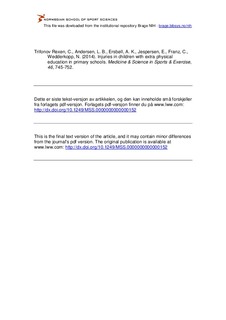| dc.contributor.author | Trifonov Rexen, Christina | |
| dc.contributor.author | Andersen, Lars Bo | |
| dc.contributor.author | Ersbøll, Annette Kjær | |
| dc.contributor.author | Jespersen, Eva | |
| dc.contributor.author | Franz, Claudia | |
| dc.contributor.author | Wedderkopp, Niels | |
| dc.date.accessioned | 2016-04-06T09:15:00Z | |
| dc.date.available | 2016-04-06T09:15:00Z | |
| dc.date.issued | 2014-04 | |
| dc.identifier.citation | Medicine & Science in Sports & Exercise. 2014, 46, 745–752. | nb_NO |
| dc.identifier.uri | http://hdl.handle.net/11250/2384233 | |
| dc.description | I Brage finner du siste tekst-versjon av artikkelen, og den kan inneholde ubetydelige forskjeller fra forlagets pdf-versjon. Forlagets pdf-versjon finner du på www.lww.com: http://dx.doi.org/10.1249/MSS.0000000000000152 / In Brage you'll find the final text version of the article, and it may contain insignificant differences from the journal's pdf version. The definitive version is available at www.lww.com: http://dx.doi.org/10.1249/MSS.0000000000000152 | nb_NO |
| dc.description.abstract | Purpose: (1) Examine the influence of extra physical education (EPE) on the number of musculoskeletal injuries in public schools accounting for organized sports participation (OSP) outside school. (2) Examine the major injury subgroup: growth-related overuse (GRO) through the overuse-related injury group.
Methods: A longitudinal controlled school-based study among Danish public schools. At baseline, 1216 children participated age 6.2–12.4 yr. Six schools (701 children) with EPE and four control schools (515 children) were followed up with weekly automated mobile phone text messages for information on musculoskeletal problems and OSP. Health care personnel diagnosed the children according to the World Health Organization’s International Classification of Diseases, Tenth Revision. Data were analyzed using a two-part zero-inflated negative binomial (ZINB) regression model.
Results: School type had no influence on the odds of sustaining an injury but increased the probability of sustaining a higher injury count for children with injuries, with total injuries by a factor of 1.29 (95% confidence interval [CI] = 1.07–1.56), overuse by a factor of 1.29 (95% CI = 1.06–1.55), and GRO by a factor of 1.38 (95% CI = 1.02–1.80). Weekly mean OSP decreased the odds of belonging to the group of children with no injuries, by a factor of 0.29 (95% CI = 0.14–0.58), 0.26 (95% CI = 0.14–0.48), and 0.17 (95% CI = 0.06–0.52) for total, overuse, and GRO, respectively. OSP also increased the probability of sustaining a higher injury count for children with injuries by a factor of 1.11 (95% CI = 1.02–1.22), 1.10 (95% CI = 1.00–1.22), and 1.14 (95% CI = 1.00–1.30), respectively.
Conclusions: Children enrolled in EPE schools with high OSP have the highest odds of injury and a high probability of sustaining a higher injury count compared to their peers at schools with normal PE. Special attention should be assigned to these children during compulsory PE. | nb_NO |
| dc.language.iso | eng | nb_NO |
| dc.publisher | American College of Sports Medicine | nb_NO |
| dc.subject | sports participation | nb_NO |
| dc.subject | adolescents | nb_NO |
| dc.subject | exercise | nb_NO |
| dc.subject | school intervention | nb_NO |
| dc.subject | injuries | nb_NO |
| dc.title | Injuries in children with extra physical education in primary schools | nb_NO |
| dc.type | Journal article | nb_NO |
| dc.type | Peer reviewed | nb_NO |
| dc.subject.nsi | VDP::Social science: 200 | nb_NO |
| dc.subject.nsi | VDP::Social science: 200::Social science in sports: 330 | nb_NO |
| dc.subject.nsi | VDP::Social science: 200::Social science in sports: 330::Other subjects within physical education: 339 | nb_NO |
| dc.source.journal | Medicine & Science in Sports & Exercise | nb_NO |
| dc.identifier.doi | 10.1249/MSS.0000000000000152 | |
| dc.description.localcode | Seksjon for idrettsmedisinske fag / Department of Sports Medicine | nb_NO |
